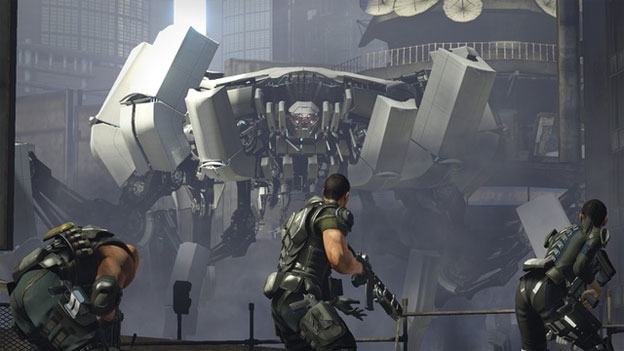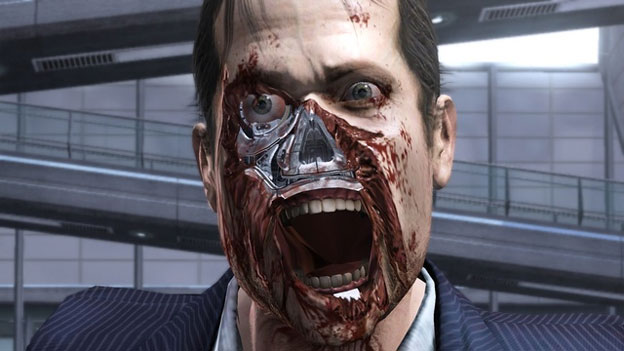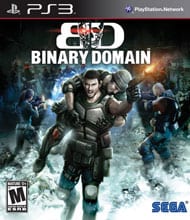Like A Mass-Produced Robot
Binary Domain is SEGA’s latest attempt to jump into the third-person shooter scene. In today’s market, shooters are a dime a dozen, and you don’t have to look hard to find a buzz-cut, gun-toting, grey armored main character ready to roadie run and duck behind cover. Binary Domain doesn’t do a lot to separate itself from this cookie-cutter formula, but on the upside, it at least executes this formula well. It’s as if the game picks and chooses good ideas from other shooters of this gaming generation and puts them together to create a moderately fun yet wholly unoriginal experience.
Robots are the enemy du jour in Binary Domain. In the future, humanity has gotten so advanced that it has made androids that are indistinguishable from other human beings. These androids, working out of self-preservation, decide that humanity is a threat. Considering that they have already begun to infiltrate our society, it’s only a matter of time before they rise up and cause the robot apocalypse. It’s up to you, Sergeant Dan Marshall, to fight against this robot uprising, protect humanity, and take down the corporation that built these robots in the first place. If this story sounds familiar to you, it’s because you’ve probably seen it before in Blade Runner , Terminator , I, Robot , or a similar film. Binary Domain doesn’t innovate with its story as much as it just copies from stories that have entertained in the past. It’s not poorly written, but it does feel a little cheap.

How will you fight against the robot revolution? Cover-based shooting, of course! All of the classic third-person shooter tropes are here. You can duck from cover to cover, roadie run, blind fire, and more. Your weapons are the basic array of machine guns, shot guns, missile launchers, and other third-person shooter staples. None really stick out as interesting or creative, but at the same time none are hard to use. There is a weapon customization system, but it doesn’t do much besides make your guns feel like slightly stronger versions of the guns you were already using. You can melee attack your foes, but this does very little damage and swings slowly enough that it’s basically useless in any situation outside of panicked flailing.
There are some flaws in the system, including the need to stand up and break cover when turning a corner, but none of these flaws make the game hard to play. Nine times out of ten you’ll simply use all the skills you learned in Gears of War and you’ll be just fine. The tenth time will be a cheap death due an odd hit-detection system. It’s not really that annoying; it’s just noticeable. I’m not sure if this is a flaw in the cover or the projectile system, or if it’s a flaw at all. It might just be a case of A.I. that suddenly gets way too good, which is appropriate considering the subject matter.

When we first saw this game at E3, we were told that it was going to have a deep “loyalty” system that would make your squad less responsive if you let them get shot in battle or make poor choices. It turns out that this system isn’t that deep at all. If you try really hard to be a total jerk, your squad mates will sometimes tell you “I’ll get to it later,” when you give them an order. This comes off as more than a little backward when you give them orders like “take cover,” which can only serve to protect them. They’ll end up standing around procrastinating while enemies plug them full of bullets.
Luckily, this doesn’t happen all that often. Simply playing the game normally will generally keep your squad mates happy. Nearly every order you give will be listened to without question. In the end it’s really more like this system doesn’t really exist at all. I can’t complain because it doesn’t make the game any worse to play, but it feels like lost potential; it’s something that could have been really cool if it were just expanded a little bit.

Another interesting feature is the game’s voice recognition system. You’re limited to simple commands in battle like “regroup,” “charge,” and “wait,” and the system actually knows what you are saying more often than not. The game has a built-in recognized word list that shows you how often your commands are recognized accurately, and you can even run voice recognition tests on words the system has trouble understanding. You can still give your squad commands with buttons, like a normal game, and it’s useful to have your most often used orders queued up so that the game doesn’t make a voice recognition error in the middle of combat. Still, the voice recognition is a neat gimmick, and it certainly makes the game more immersive.
The environments and set pieces in Binary Domain are actually rather impressive. You’ll fight gigantic robotic bosses, pick off pursuers during high-speed chase scenes, protect your squad members during scripted danger sequences, and much more. Once again, you’ve pretty much done this all before in every other shooter on the market, but that doesn’t make it any less fun. Binary Domain makes sure to hit every note that its predecessors hit before it—if it worked then, it works just as well now.
Shooting robots is way more fun than shooting humans or zombies. No matter what you do, these robots will keep coming after you until you shatter them into tiny pieces. It’s a lot like Dead Space in that you need to be wary of where you are shooting your enemies. You can dismember your robotic foes, but they will keep coming at you, even if they have to drag their bisected torso along the ground by their arms. You can shoot out your enemies’ limbs to disarm them and make them less of a threat, and you can shoot off your enemies’ heads to make them shoot blindly at their allies. In fact, the system is so flexible it almost feels broken. As long as you are shooting something, somewhere, then you are playing the game correctly.
In a massive oversight, SEGA has neglected to allow the single-player campaign to be played in co-op mode. This is a horrible decision, considering the game has such a huge focus on squad-based tactics. The game has online competitive multiplayer built in, but all you’ll find here are your standard modes that every other shooter has, like deathmatch or capture-the-flag. There’s nothing that sets the game’s multiplayer apart from bigger titles like Gears of War. In fact, there’s even a mode called “Invasion,” which is essentially a variation on Horde Mode. You can choose between several multiplayer classes and customize them as you earn in-game credits, but, once again, this is nothing you haven’t seen in Gears of War or Modern Warfare, and those two games have far more players on their servers. In the end, there’s no real reason to play Binary Domain when you could be playing a game that has a larger multiplayer fan base.

The game is average length for a shooter. It’s about ten hours long if you leisurely make your way through it. The difficulty never grows too hard, and outside of a couple bugs or unseen ambushes, you’ll rarely die. The A.I. is pretty incompetent, which is unfortunate considering you are basically stuck with them. However, your character is more than powerful enough to make up for their shortcomings. It’s just you against hordes of robotic armies for ten straight hours, which itself is pretty damn fun.
In the end, I can’t say that Binary Domain is a bad game, but it’s definitely a mediocre game. It plays it safe in every way possible. It’s only feature of note is its voice recognition system, but everything else feels like it came straight out of a How to Make a Cover-Based Shooter for Dummies book or something. It’s not bad; it’s just generic. It’s a “me too” game that tries to sell you on ideas that could be awesome but aren’t fleshed out all that well.
Binary Domain is a great rental if you are looking for a shooter to hold you over to the next big release, but if you buy it, it will probably spend most of its time on your shelf.
RATING OUT OF 5 RATING DESCRIPTION 3.4 Graphics
The animations are smooth, but it’s sometimes hard to tell when you are actually hitting your enemy. 3.8 Control
The controls are tight enough and the voice recognition is pretty innovative. 3.1 Music / Sound FX / Voice Acting
The soundtrack is nothing special. The voice acting is competent, but the dialogue sometimes comes off as forced and unbelievable. 3.2 Play Value
It’s fun as a rental, but there’s no real reason to rush out and add Binary Domain to your collection. 3.4 Overall Rating – Fair
Not an average. See Rating legend below for a final score breakdown.
| Review Rating Legend | |||
|---|---|---|---|
| 0.1 – 1.9 = Avoid | 2.5 – 2.9 = Average | 3.5 – 3.9 = Good | 4.5 – 4.9 = Must Buy |
| 2.0 – 2.4 = Poor | 3.0 – 3.4 = Fair | 4.0 – 4.4 = Great | 5.0 = The Best |
Game Features:
